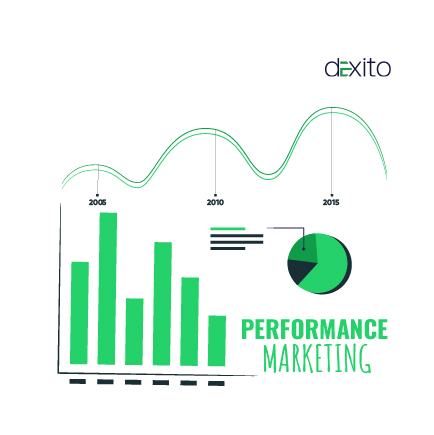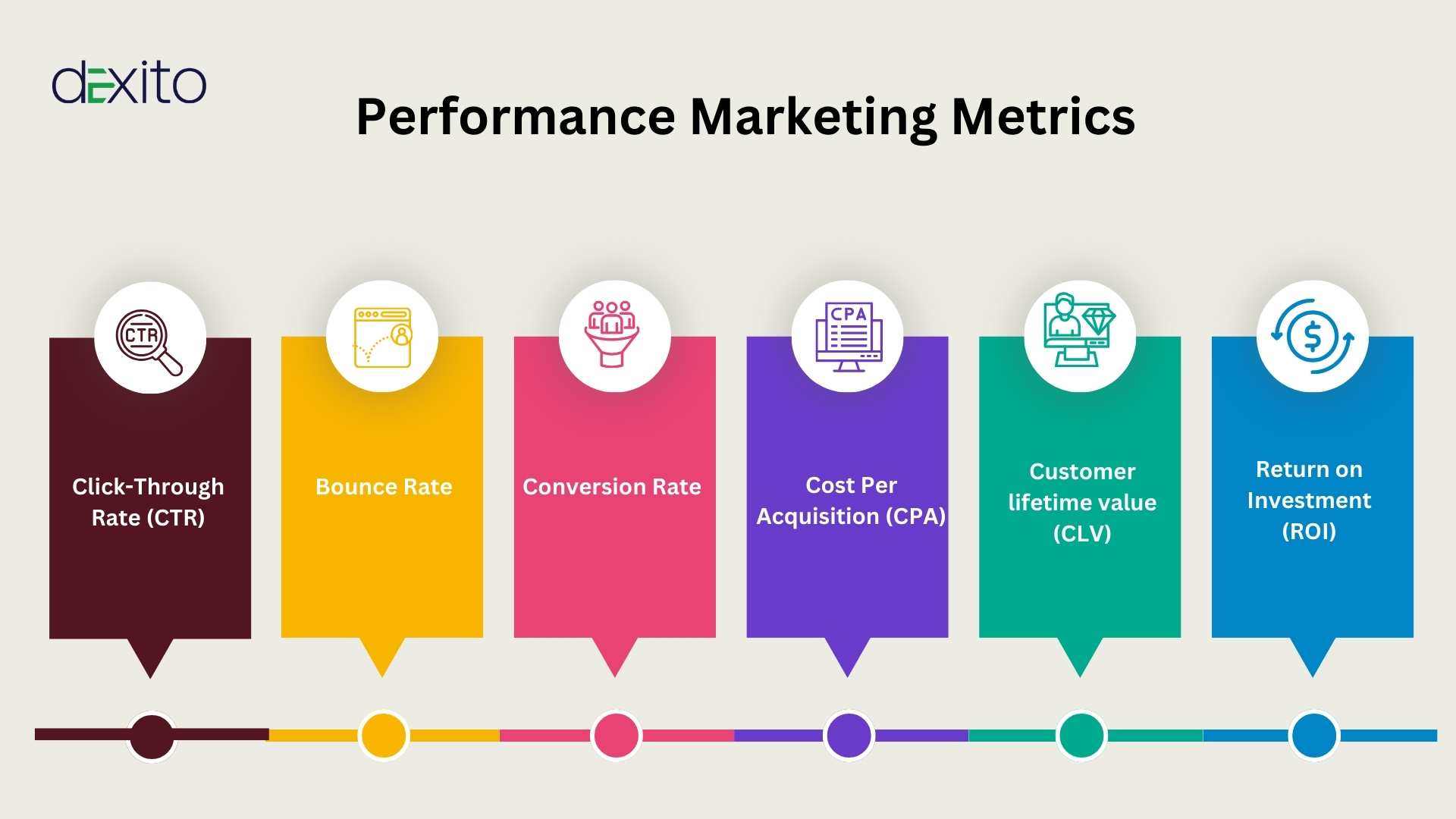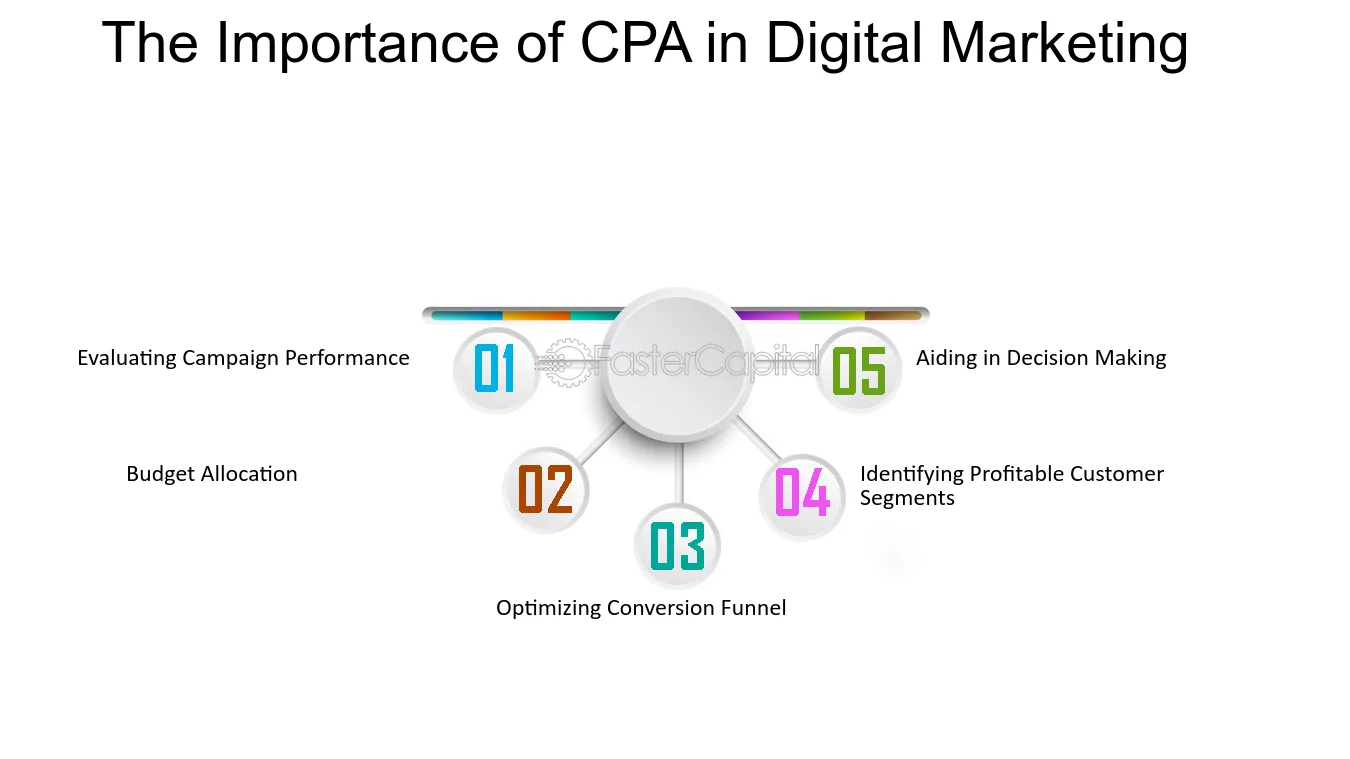Top Performance Marketing Metrics you Need to Track For Success

Nowadays, performance marketing has developed as a key solution for marketers, those who are trying to achieve measurable results and advance their marketing investments. The active use of performance marketing metrics can give an understanding of different forms of campaign validity. Metrics like click-through rate (CTR), return on investment (ROI), cost per acquisition (CPA), conversion rate, customer lifetime value (CLV), and bounce rate offer beneficial results about how the marketing efforts connect with viewers and reach effective business objectives. Performance Marketing Strategies play a crucial role in optimizing these metrics for better outcomes.
These will allow businesses to approach the Benefits of Performance Marketing and provide opportunities for regular development. Understanding these key metrics can help marketers refine their strategies, assign financial plans skillfully, and eventually increase their return on investment. Here, we brief out the importance of the performance marketing metrics, their definitions, and the role that they have in successful marketing resources.
If you are a fresher or seasoned marketer in this field, capturing these performance marketing metrics will allow you to improve the campaign and grab continuous growth in the quickly developing market industry:
Also Read: Top Performance Marketing Channels for Businesses in Kerala
Table of Contents
ToggleWhat do you mean by Performance Marketing Metrics?
Performance marketing metrics are the specific function that assists marketers in measuring their success in marketing campaigns through tracking particular outcomes and actions. These types of metrics offer a quality understanding of how strongly a campaign is performing by focusing on measurable impacts. They allow businesses to know which strategies are active in customer participation, regularly increasing sales, and developing leads. Marketers are well able to fine-tune their messaging, effectively utilize their budgets, and also optimize their campaigns through understanding these metrics. Identifying performance marketing metrics will help to know the areas that need improvement, assuring that the marketing efforts are impressive and cost-effective, increasing return on investment.

Click-Through Rate (CTR)
This is one of the most significant performance marketing metrics applied to calculate the achievement of online campaigns. In performance marketing, Click-Through Rate views the percentage of the audience who click on a link, ad, or call-to-action compared to the whole number of impressions, assuring it how relevant and committing your content to your target audience. The high CTR will mention your marketing message, visuals, and the whole advertising strategy connecting with the right audience, supporting them to take action. This makes the click-through rate a priceless metric for maximizing paid advertising efforts, like Google ads, email marketing, and social media campaigns where the aim is to make the users down the graph towards conversions. As performance marketing depends on measurable outcomes, CTR has a fundamental character in assisting businesses in analyzing whether the campaigns are sufficiently understanding the audience interest. A low CTR can show the issues with advertising importance, poor targeting, and an unattractive offer, suggesting businesses identify their strategies. So, proper analysis and developing CTR within the content of the performance marketing metrics can help you achieve a perfect commitment and increase the return on investment (ROI).
Conversion Rate
The conversion rate is the kind of percentage of the audience who complete an appropriate action on your website, like signing up for a newsletter, making a purchase, and downloading an app. In this process of performance marketing, the focus is on achieving measurable results. Here, it provides a proper guide to how the campaigns are changing website visitors or ad clicks into proper customers. A good conversion rate indicates your marketing strategy, call-to-actions, and landing pages are significantly convincing users to take the next step, lifting them from the awareness of action. However, the poor conversion rate can expose gaps in the user experience, poor targeting, and improper messaging; all of these will be addressed for campaign optimization. Performance marketing is all about heightening return on investment, testing different ad creatives, improving conversion rates through clarifying the landing pages, and customizing audience journeys to make more cost-effective campaigns. Following conversion rates close to others’ performance marketing metrics assist in making sure that the campaigns are developing traffic and converting the traffic into productive and revenue-generated actions.
Cost Per Acquisition (CPA)
Cost per acquisition (CPA) is a major performance marketing metric that calculates how much it costs to achieve a new customer through marketing efforts. CPA measures the whole marketing payment divided by the number of conversions, offering a proper and clear vision of the economic strategy of a campaign. Every dollar paid wants to be explained by calculating the outcomes; cost per acquisition is important in identifying if your campaigns are cost-effective. A low CPA shows that your marketing strategy is strongly operating the conversions at a lower price.

The Importance of CPA in Digital Marketing– Image Source: Faster Capital
However, a high CPA means you are paying too much to achieve new customers. CPA is normally beneficial for marketers who depend mostly on paid advertising, like social media ads, PPC, and affiliate marketing, while it directly connects to the ROI. controlling and optimizing CPA, including targeting, improving remarketing, developing ad creatives, and constantly testing various appearances to lower prices. Businesses can make informed decisions to increase campaign performance by tracking CPA in combination with other performance marketing metrics like ROI and conversion rate. Businesses can make informed decisions to achieve campaign performance, making sure they grab customers at a profitable cost.
Customer lifetime value (CLV)
This is a significant performance marketing metric that analyzes the grand revenue a business can expect from each customer over the validity of their connection with the brand. In performance marketing, CLV is significant in identifying the long-lasting value of customers achieved through marketing efforts. Different metrics focus on short-term growth. Customers continue with the brand growth and make multiple purchases, which allows cooperatives to pay more for customers’ achievements, recognizing they will recover the investment over time. Realizing CLV is especially valuable when calculating campaigns that concentrate on customer loyalty and maintenance functions, as these efforts normally influence how much trust a customer will offer over the long term. Analyzing CLV includes strategies like developing customer services, customizing marketing efforts, and supporting continuous purchases through loyalty rewards.
Return on Investment (ROI)
In performance marketing metrics, Digital Marketing ROI is the most powerful metric, which offers a direct value of the profitability of marketing campaigns by calculating the income generated in connection to the costs sustained. ROI assists businesses in knowing the financial importance of the efforts, making them analyze if the revenue generated from a campaign validates the functions assigned to it. A good ROI shows that the marketing strategy is producing more revenue than it costs, making it a main source of achievement. However, a negative ROI means alterations are needed to develop the campaign sufficiently. Identifying ROI associated with other performance marketing metrics, like CPA and conversion rates, helps marketers achieve a great understanding of the overall marketing performance. Observing and developing ROI can make sure the performance marketing programs contribute properly to all.
Bounce rate
Bounce rate is a major performance marketing metric that calculates the visitors who leave a website after seeing it a single time without doing anything with the site. A good bounce rate can show the current pages or ads are not connected to your viewers, recommending solutions with user experience, targeting, or content relevance. For businesses, knowing the bounce rate is sufficient because it directly affects the whole campaign productively. When the audience is bouncing away quickly, it is called that they are not identifying the needs or not interested in their presented content. This may be a wasted marketing expenditure. Strategies to decrease the bounce rate will involve optimizing the current design of the page, developing page load speed, making sure the messaging aligns with users, and also improving the content quality, which visions are arranged by the search results or ads. Businesses can develop customer engagement and likelihood conversions by actively working to lower bounce rates, therefore clarifying the whole productivity of the performance marketing efforts.
Conclusion
The significance of following performance marketing metrics cannot be overvalued. Metrics like click-through rate (CTR), conversion rate, cost per acquisition (CPA), customer lifetime value (CLV), return on investment (ROI), and bounce rate offer a specified understanding of which makes businesses measure the achievement of the campaigns, improve viewer performance, and identify the strategies. Besides analyzing the performance marketing metrics, marketers can understand the trends, customer behavior, and accessible data-driven decisions that are made to increase marketing outcomes. These regular activities of observing and clarifying strategies related to valuable results increase the return on investment and also develop a culture of finance and improvements within cooperative teams. Continuously increasing metrics can help marketers coordinate their marketing efforts to achieve marketing goals and maintain long-term success and profitability. Accepting performance marketing metrics is the way to gain measurable success and grab a competitive advantage.
dExito is the Leading Performance Marketing Agency in Kerala. As a Digital Marketing Company in Kerala, we help you lift your business to a high level. So, for more details, get in touch with us right now.

Salmanul Faris, Founder of dExito Branding, is a seasoned Performance Marketing Expert with over 8 years of experience in Google Ads and Meta Ads. He specializes in helping businesses across India and the GCC achieve measurable growth through data-driven marketing strategies. Amidst his dynamic role at dExito, he shares insights on the latest trends in digital marketing and performance marketing, helping brands stay ahead in the competitive digital landscape